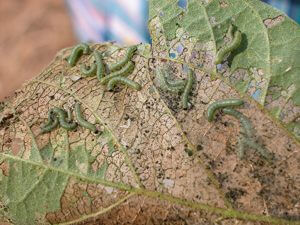Management Options
| Insecticide (Trade Names) for BEET ARMYWORM | Lb Active Ingredient per Acre | Amount Formulation per Acre | Performance Rating |
|---|---|---|---|
| chlorantraniliprole (Vantacor 5 SC) | 0.067 - 0.089 | 1.71 - 2.28 oz | 9? |
| chlorantraniliprole, bifenthrin (Elevest) | See label | 5.6 - 9.6 oz | 9? |
| chlorantraniliprole, λ-cyhalothrin (Besiege) | See label | 8 - 12.5 oz | 9? |
| emamectin benzoate (Denim 0.16) | 0.0075 - 0.01 | 6 - 8 oz | 9 |
| indoxacarb (Steward 1.25) | 0.09 - 0.11 | 9.2 - 11.3 oz | 9 |
| methoxyfenozide (Intrepid 2) | 0.06 - 0.16 | 4 - 10 oz | 9 |
| spinetoram (Radiant SC 1) | 0.033 - 0.0625 | 4.25 - 8 oz | 9 |
| spinetoram, methoxyfenozide (Intrepid Edge) | See label | 4 - 8 oz | 9 |
| spinosad (Blackhawk 36% WDG) | 0.056 - 0.072 | 2.4 - 3.2 oz | 9 |
- Production of an early crop and preservation of beneficial insects will reduce the risk of a beet armyworm outbreak.
- Bt cottons generally provide good control of beet armyworms. Supplemental insecticide applications are unlikely unless infestation levels are unusually high.

